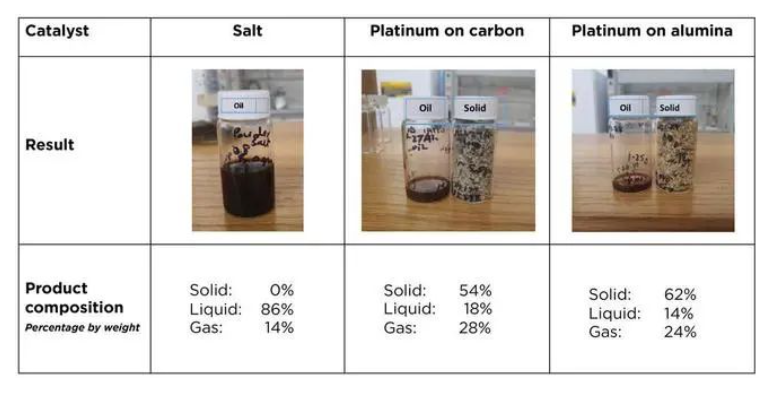Muhammad Rabnawaz, Associate Professor at Michigan State University’s Top Packaging School
Rabnawaz and his colleagues showed that sodium chloride, table salt, performed much better than more expensive materials being explored to help recycle plastics.

Better than expensive catalysts
Although plastic has historically been promoted as recyclable, the reality is that nearly 90% of plastic waste in the United States ends up in landfills, incineration, or becomes environmental pollution.
“It’s really exciting,” Rabnawaz said. “We need simple, low-cost solutions to big problems like plastic recycling. One of the reasons plastics have become so disposable is that the materials recovered from recycling are not valuable enough to spend the money and resources required to obtain them According to the team’s predictions, table salt could turn around the economy and drastically reduce costs when it comes to a recycling process called pyrolysis, which occurs through a combination of heat and chemistry.
Although Rabnawaz expected the salt to have an impact because it conducts heat well, he was still surprised by its effectiveness. It outperforms expensive catalysts and chemicals designed to stimulate reactions, and he believes his team is just beginning to tap into its potential. In addition, the work has attracted the attention of prominent figures in the industry, he said. In fact, this research was supported by consumer product companies
Supported in part by Conagra Brands.
Elimination of wax by-products from polyolefin pyrolysis
Pyrolysis is the process of breaking down plastic into a mixture of simpler carbon-based compounds, which come in three forms: gas, liquid oil, and solid wax. Rabnawaz said this wax ingredient is generally unpopular, but it accounts for more than half of current pyrolysis products by weight. This is true even when catalysts are used, which are useful, but they can often be toxic or costly to process waste plastics.
For example, platinum has very attractive catalytic properties, which is why it is used in catalytic converters to reduce harmful emissions from cars. But it’s also very expensive, which is why thieves steal catalytic converters. Rabnawaz said that while bandits are unlikely to snatch platinum-based materials from sweltering pyrolysis reactors, trying to recycle plastics with these catalysts would still require a huge investment, likely millions, if not hundreds of millions of dollars. . Current catalyst efficiencies are insufficient to justify this cost.
“No company in the world has that much cash to burn,” Rabnawaz said.
In earlier work, Rabnawaz and his team showed that copper oxide and table salt could act as catalysts for breaking down polystyrene plastic. Now, they have shown that table salt alone can eliminate wax byproducts produced during the pyrolysis of polyolefins, a polymer that accounts for a large portion of plastic waste.
60%.
“The first paper was important, but I didn’t get excited until we were working on polyolefins,” Rabnawaz said. “Polyolefin yields are huge, and our performance outperforms expensive catalysts.”
Joining Rabnawaz on the project are Christopher Saffron, associate professor in the College of Agriculture and Natural Resources, and visiting scholar Mohamed Shaker
and Vikash, a doctoral student at Michigan State University.
Kumar. When pyrolyzing polyolefins using table salt as a catalyst, much of the liquid oil the team produced contained hydrocarbon molecules similar to those found in diesel fuel, Rabnawaz said. The researchers showed that another advantage of the salt catalyst is that it can be reused.
“The salt can be recovered simply by washing the oil obtained with water,” Rabnawaz said.
Common salt contributes to the pyrolysis of metallized plastic films
The researchers also showed that table salt contributes to the pyrolysis of metalized plastic films, which are commonly used in food packaging, such as potato chip bags, which are currently not recyclable. Although pure table salt did not perform better than the platinum alumina catalyst, the team also tested using metallized films with similar results, and the salt was a fraction of the cost.
Rabnawaz stressed, however, that metallized films, while useful, are inherently problematic. He envisions a world where such films are no longer needed, which is why his team is also working to replace them with more sustainable materials. The team will also continue working to advance its pyrolysis project.
For example, the team has yet to fully characterize the gas products from the pyrolysis of table salt. Rabnawaz believes the team can improve the method so that the chemicals contained in the liquid product have a more valuable use than burning them as fuel.
Still, the early returns on the team’s new salt strategy are encouraging. The team estimates that commercial pyrolysis reactors could triple profits simply by adding salt, according to a preliminary economic analysis supported by the U.S. Department of Agriculture and Michigan State University’s Agricultural Biological Research Center.



 微信扫一扫打赏
微信扫一扫打赏
